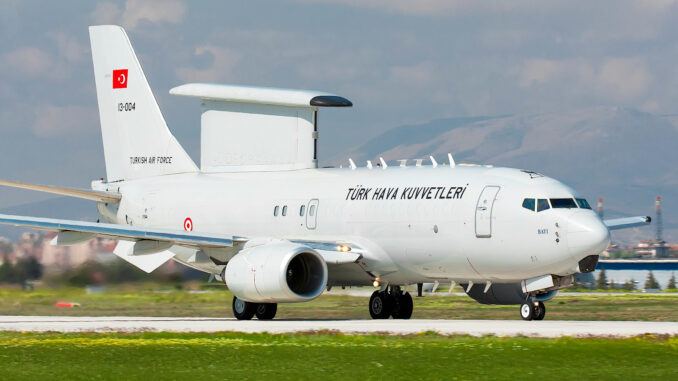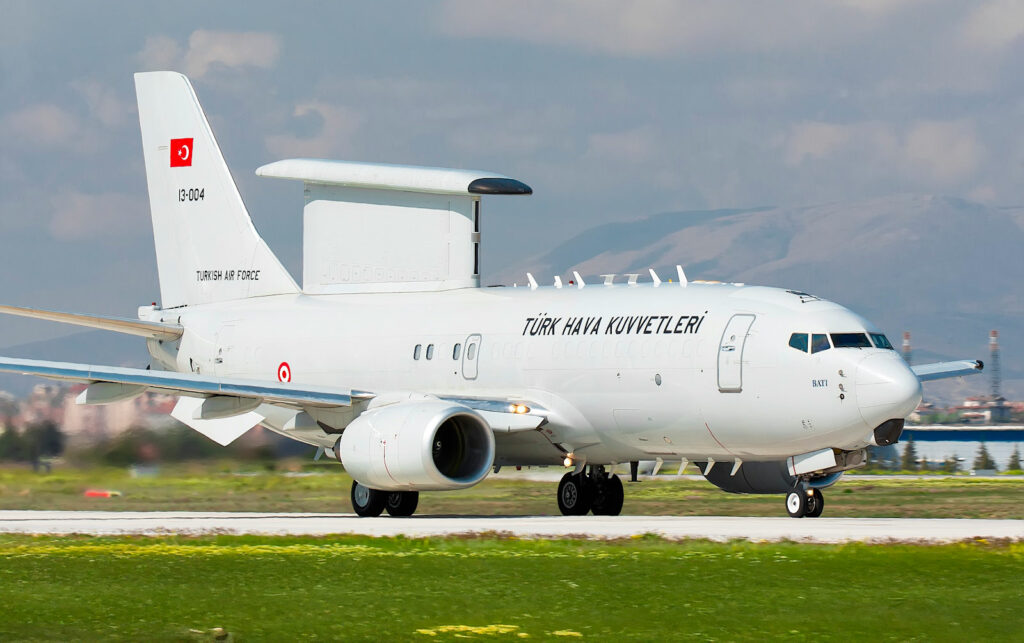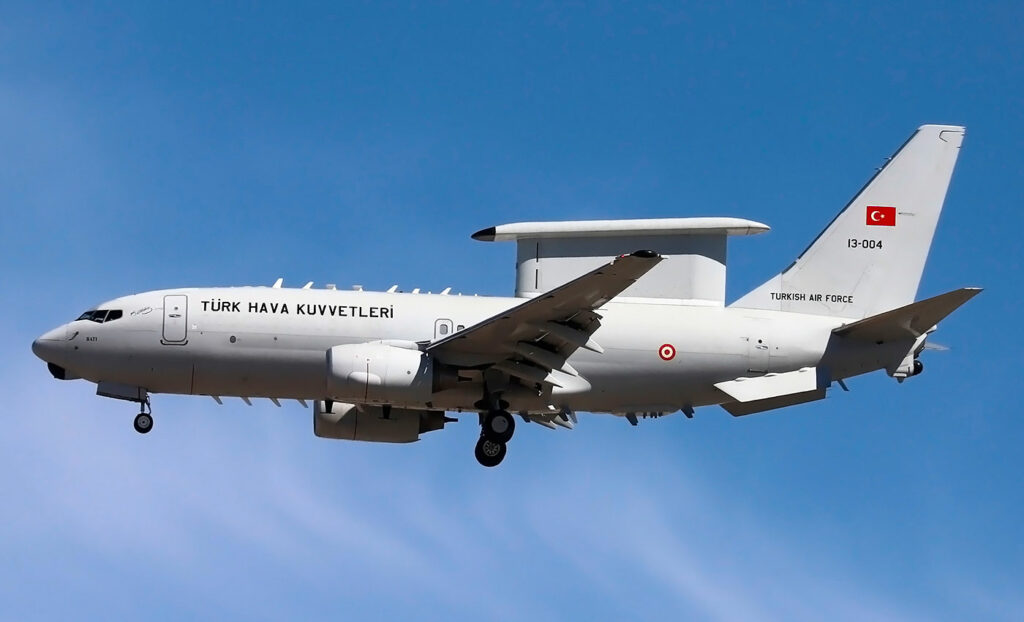
Analysis of the Boeing 737 Peace Eagle’s military engagements and the technological developments planned to enhance its AEW&C capabilities.
The Boeing 737 Peace Eagle is an Airborne Early Warning and Control (AEW&C) aircraft. It is based on the Boeing 737-700 Next Generation platform. Development began in the early 2000s. The aim was to meet the surveillance and tactical coordination needs of the Turkish air force. The military authorities were looking for a multi-purpose aircraft, capable of covering vast areas while incorporating modern detection technologies. Adaptations include a top-mounted radar, a secure electronic architecture and a series of mission consoles. Since its introduction, this aircraft has been used in a variety of theaters of operation, with a particular focus on high-risk border regions. The following sections look at the Boeing 737 Peace Eagle’s history of military use, followed by a discussion of the technological developments that will enhance its role in operational planning.

Background to the Boeing 737 Peace Eagle
Before analyzing the history of commitments and future developments, it is worth recalling that the Boeing 737 Peace Eagle is the result of a major contract signed between Boeing and Turkey, valued at over 1.3 billion euros. The aircraft is around 33.6 meters long, with a wingspan of around 35.9 meters. It retains the flying qualities of the civil 737-700, but carries a MESA (Multi-role Electronically Scanned Array) radar designed to cover 360 degrees. Detection and control tasks are performed by several operators. Mission duration is up to eight hours, sometimes more if in-flight refuelling is available. On the practical side, software upgrades enable radar algorithms to be fine-tuned, improving detection performance. This AEW&C model is classified as E-7T in Turkish documents.
Overview of AEW&C missions
The primary mission of the Boeing 737 Peace Eagle is to provide advanced aerial surveillance, identify potential threats and transmit this information to in-flight units and ground control centers. Thanks to an encrypted communication system, it shares critical data in near-real time. This interconnection facilitates fighter coordination and airspace protection. The aircraft can also monitor maritime movements and help protect coastal areas. Allied military exercises often feature its data fusion capabilities, which facilitate a comprehensive overview of operations.
History of military engagements
The Turkish Air Force has deployed the Boeing 737 Peace Eagle in several areas of tension. Detailed data may remain confidential, but various testimonials and public sources highlight several types of engagement:
- Border surveillance and aerial observation
Regional tensions have prompted the authorities to step up border surveillance, particularly in the south-east of the country. The Boeing 737 Peace Eagle reportedly patrolled at altitudes in excess of 10,000 meters, to detect any undeclared air movements. Operators on the ground received a constant flow of radar data, which improved reactivity in the event of a threat. - Conflict in Syria
According to unofficial sources, the Boeing 737 Peace Eagle was used to spot and track unknown air formations in the airspace around Syria. The aircraft then served as an information relay for Turkish F-16 fighters. These missions would have helped to better manage the airspace in times of tension, particularly when foreign military aircraft were flying close to the border. - Security patrols during sensitive events.
Several reports indicate that the Boeing 737 Peace Eagle has been mobilized during regional events considered to be at risk. In these cases, the aircraft provided real-time monitoring of air activity, to prevent any intrusion. Joint maneuvers with NATO also highlighted its ability to exchange data via secure links (such as Link 16). - Multinational exercises
The Turkish armed forces took part in training exercises with other NATO member countries. The Boeing 737 Peace Eagle demonstrated its ability to coordinate different aircraft, such as fighters, helicopters and drones. The radar coverage provided made it possible to simulate complex scenarios, where the simultaneous management of multiple air and sea threats is crucial. Feedback confirmed the reliability of the AEW&C concept, derived from the base 737. - Operational feedback
Over the years, the aircraft has established itself as a major asset for the Turkish Air Force. Thanks to its global view of air traffic, it has helped strengthen interception and crisis management capabilities. Some pilots have even commented on the aircraft’s contribution during critical mission phases. The military community believes that the integration of advanced radar and communication systems has enabled greater responsiveness to potential violations of Turkish airspace.
This list is not exhaustive, as all missions remain confidential. However, the experience gained has validated the relevance of deploying such a tool for strategic surveillance and tactical coordination.
Impact on doctrine and operational planning
The deployment of the Boeing 737 Peace Eagle has changed air defense planning methods. Feedback shows that the aircraft has become a hub for real-time supervision. Mission commanders receive comprehensive data on the air and sea situation. Decisions to intercept or reallocate air assets are then based on reliable information. This approach has influenced Turkish doctrine, with its emphasis on rapid centralization of tactical data. It has also inspired other air forces to monitor the effectiveness of AEW&C aircraft in sensitive areas.
Technological prospects
The Boeing 737 Peace Eagle benefits from modernization programs to maintain a technological level adapted to current threats. Several avenues are envisaged:
- Improving radar range.
Engineers plan to optimize the MESA radar, by introducing modules capable of detecting targets at longer range. Calculations show that the current range, already in excess of 370 km under standard conditions, could be increased by 15-20% depending on the configuration. This would mean a greater ability to monitor large areas, including the high seas. - Integration of additional sensors
The air force is studying the possibility of installing infrared or electro-optical sensors. These systems, already used on maritime surveillance aircraft, would make it easier to identify small naval targets or low-flying drones. The aim is to broaden the range of observation capabilities, based on multi-sensor technologies. - Strengthening communications
Securing communications is a major challenge. Operators are planning to add new encrypted protocols compatible with recent NATO standards. This would enable faster data transmission, while making electronic interception more complex for an adversary. Improved satellite links would also offer the possibility of communicating over long distances, beyond the range of ground stations. - Reducing the electromagnetic signature
Some of our work focuses on optimizing the radar antenna and onboard systems to limit detectable emissions. The experts aim to make the aircraft less detectable by enemy electronic listening devices. This approach is based on adjusting radar scanning modes and protecting certain electronic components. - Automation and ergonomics
Mission consoles could eventually incorporate more automation, thanks to artificial intelligence. For example, an advanced algorithm would be able to prioritize identified threats and suggest actions to operators. This would reduce the workload, by filtering out echoes considered less relevant. Operators would then concentrate on tactical interpretation and decision-making. - Long-term prospects
The future of the Boeing 737 Peace Eagle will depend on the durability of its key systems. The 737-700’s airframe is robust, but improvements to radar and mission capabilities will require a substantial budget over the coming decades. Specialists are also looking at integrating emerging technologies such as machine learning-based data analysis. This could refine fault diagnosis and predictive maintenance.

Implications for allied forces
Turkey’s allied forces, notably those of NATO, are closely following the development of the Boeing 737 Peace Eagle. Some countries already have AEW&C aircraft (such as the E-3 Sentry), but the rapid modernization of the Turkish E-7T illustrates the need to maintain a high-performance surveillance fleet. International cooperation could include the sharing of expertise in sensor integration or the pooling of communication systems. During joint exercises, the presence of a Peace Eagle AEW&C aircraft enhances coordination between participants.
The Boeing 737 Peace Eagle has already proved its worth in high-tension environments, enhancing air vigilance and safety. Its deployment in border areas, notably during the conflict in Syria, illustrates the versatility of this aircraft. Thanks to its MESA radar, encrypted data links and coordination capabilities, it remains an asset for Turkish defense and a subject of interest for international experts. On the technological front, future upgrades promise to further enhance its usefulness in managing complex operations. Trends indicate that the introduction of new sensors and improved communication protocols will make the Boeing 737 Peace Eagle an increasingly effective surveillance tool. Maintaining such an aircraft, however, requires regular investment and anticipation of emerging threats.
War Wings Daily is an independant magazine.